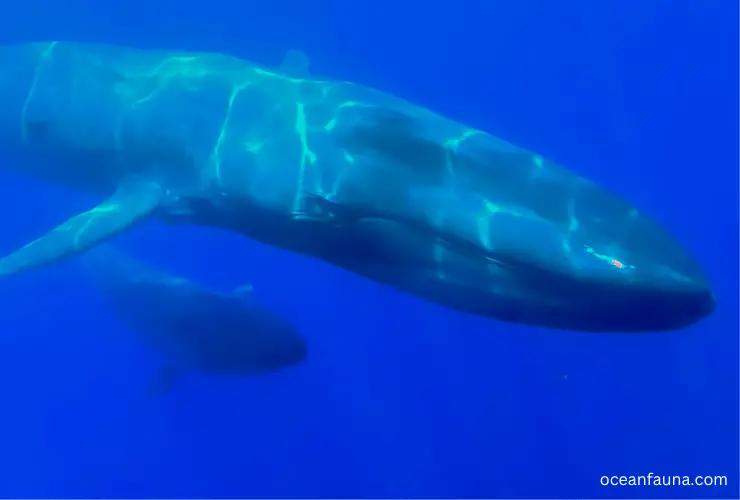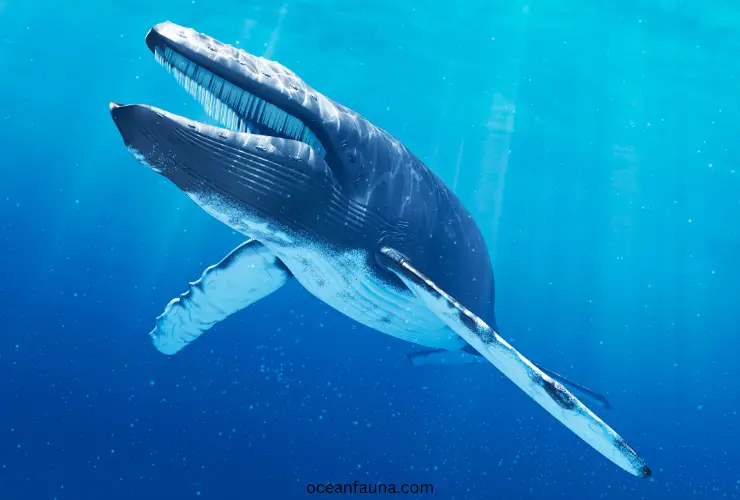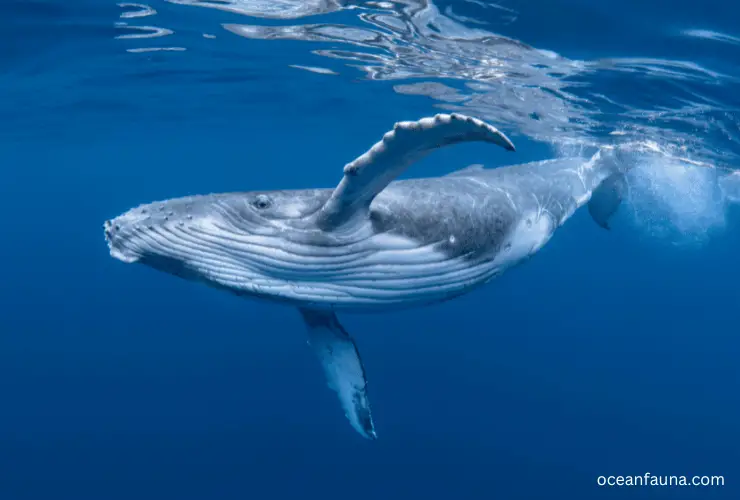From a report, I know that over 1000 whales are hunted yearly for the huge demand for their meat, oil, and other body organs. And then, a question popped into my mind, “Can you eat whale?” The simple answer is “Yes.”
While it’s true that whale meat is consumed in various cultures, its availability and cost set it apart from common meats like beef or chicken. In this blog, I will discuss in detail the advantages and disadvantages of eating whale meat. I will also explain how whale meat tastes. So read on the blog to discover some interesting facts.
Can You Eat Whales?

“Is whale meat edible? Yes, you can eat whale meat. Whale meat is still a food source and a delicacy for many people and cultures. This includes those in Canada, Greenland, Iceland, Norway, Japan, and the Inuit of the United States.
Yet, hunting whales, especially for trade, is controversial. This is due to overfishing, animal welfare, and effects on marine life.
Also, a major worry with whale meat is mercury, a toxic element. Mercury can harm the brain and cause birth defects. It’s very risky for pregnant women and children. To reduce mercury risk, it’s key to cook whale meat well. Marinating the meat in acid ((such as vinegar or citrus juice) can break down toxins.
It’s also vital to source whale meat responsibly. Ensure it’s from areas with low water pollution.
How Does Whale Meat Taste?
“What is the taste of whale meat? Does it feel good or bad? Whale meat tastes like beef but has a slightly fishy flavor. The taste comes from the whale’s diet, mainly fish and plankton. Some people also compare whale meat to reindeer and moose.
Whale meat is lean and red like beef and can be tough. The texture varies with the cut. Some cuts are tender and buttery.
Whale meat’s taste is like a mix of beef and fish. But its flavor is richer and deeper than either. It leaves a salty aftertaste with a hint of the ocean.
People prepare whale meat in many ways, including grilling, frying, sautéing, and baking. In Japan, it’s also eaten raw as sashimi. This is a delicacy, often enhanced with soy sauce or wasabi.
What Countries Eat Whale Meat Most?
Commercial whaling, condemned globally, continues in a few countries like Japan, Norway, Iceland, Greenland, Alaska, Canada, etc. Despite protests, whale meat consumption remains prevalent, especially in Western Europe and colonial America. Here are a few countries and places that eat whale meat the most:
Japan
Japan leads in whale meat consumption. In 2020, they consumed about 5,000 tons. They hunt whales under the guise of research. This meat then appears in markets and restaurants nationwide. Whale meat is a delicacy in Japan, part of their heritage. But younger Japanese are less interested in it now.
Norway
Norwegians have eaten whale meat for centuries. It’s a tradition. About 4% of Norwegians eat it regularly, especially during festivals like Christmas and Easter. The Norwegian government allows whaling. They kill about 500-600 whales yearly. Most meat stays in Norway, but some go to Japan and Iceland.
Iceland
Icelandic people also have a long tradition of eating whale meat. Before the 1986 whaling ban, 80% of Icelanders ate it often. The country resumed whaling in 2006, targeting fin and minke whales. The meat is mainly eaten in Iceland, with some exported to Japan.
Greenland
Greenland is in the North Atlantic. It’s a Danish territory. Here, indigenous people can hunt whales for food. The Inuit have hunted whales for over a thousand years. Whale meat is a regular part of their diet. They prepare it grilled, smoked, or boiled.
Alaska
In Alaska, indigenous groups like the Inupiat and Yupik rely on whale meat. They hunt bowhead whales for food and oil. This hunting is regulated. Only locals eat the meat. Recently, there’s been controversy over sport hunting by non-indigenous people.
Canada
Canada banned commercial whaling in 1972. But, indigenous people can still hunt whales for food. The Inuit and other native groups see whaling as a key tradition and nutrition source.
Can You Eat Raw Whale Meat?

Eating raw whale meat is not recommended, but if you choose to, be aware of the risks. Some cultures traditionally eat raw whale meat. However, this practice carries health risks.
Safety issues in Japan, known for its sushi, have reduced whale meat sales. Moreover, whale meat sales are limited in many countries. This is due to health risks and the endangered status of whales.
Raw whale meat often has mercury, a toxin. Eating a lot of it can lead to serious health issues. Mercury builds up in animals like whales over time. Eating whale meat with too much mercury can cause mercury poisoning. This can lead to tremors, memory loss, and trouble focusing.
Besides mercury, raw whale meat may have dangerous bacteria and parasites. These can make you sick. Whales, especially top predators, may have lots of POPs like PCBs and dioxins. These build up in their bodies.
The WHO (World Health Organization) says eating raw meat with high POPs, including seafood, can raise cancer and other health risks.
The bacteria in raw meat can also lead to illnesses like norovirus, listeria, and E. Coli. Parasites can cause diseases like anisakiasis from undercooked fish. The WHO recommends not eating raw mammal meat due to these safety concerns. It also advises cooking meat well to kill bacteria, parasites, and viruses.
How to Prepare Whale Meat?
As I said before, whale meat should not be eaten raw. It should be properly prepared before eating. Whale meat is unique and needs careful handling. This requires specific skills and knowledge.
First, buy whale meat from a reputable, sustainable source. Remember, hunting some whale species is illegal due to their endangered status. After getting the whale meat, handle it gently and store it in the fridge until cooking.
Some cook whale meat directly, while others marinate it first. Soak the meat for 30 minutes to an hour if marinating in your chosen mix. Use soy sauce, garlic, ginger, brown sugar, or other flavors that suit the meat. After marinating, grill, bake, fry, or smoke the meat.
For grilling, put the meat on a hot grill, oil it, and turn it every few minutes until done. To bake, place it in an oven at 350°F for 20-30 minutes, based on thickness. Frying is possible, but whale meat’s fat can make it splatter. Cut it into small pieces and fry on low to medium heat, turning until browned and crispy.
How you serve and garnish the meat depends on your taste. Serve it with rice, vegetables, and potatoes, or try exotic garnishes like wasabi sauce, ginger, or pickled veggies.
What Are the Health Benefits of Eating Whale Meat?

Eating whale meat offers several health benefits. Whale meat is a great source of top-grade protein, vital for body growth and repair. Protein is also key in making antibodies that battle infection.
Whale meat has a lot of Omega-3s, which are vital for heart health. They also help enhance brain health. Whale meat contains many vitamins and minerals like vitamin B12, iron, and selenium, which are crucial for overall health.
Even though whale meat is high in fat, most of this fat is unsaturated. This type of fat is better for heart health than saturated fats. The fat in whale meat is a rich energy source. This is especially useful in cold places where you need more energy.
Remember, eating whale meat has health benefits. But it’s important to get it responsibly. This is due to ethical and sustainability issues with whaling. Also, make sure to cook it well. This reduces the risk of food illnesses and exposure to harmful stuff.
What Are the Drawbacks of Eating Whale Meat?
Eating whale meat comes with several drawbacks. Whale meat can have high mercury levels. Eating too much may cause mercury poisoning. This poisoning can cause tremors, memory loss, and concentration problems.
In addition, raw or undercooked whale meat can carry harmful bacteria and parasites. These can make you sick. These include pathogens like norovirus, listeria, and E. Coli. It also includes parasites causing diseases such as anisakiasis.
Certain whales, especially those high in the food chain, build up POPs like PCBs and dioxins in their bodies. Eating this meat can raise your risk of cancer and other health issues.
Many whales are also endangered. Hunting them is often illegal and controversial. Eating whale meat poses ethical issues. It also adds to their decline.
FAQs
Is whale meat expensive?
Whale meat is indeed quite costly. The price varies by source and whale type. For example, 1 kg can cost about $500. But in Japan, a small slice may cost around $10. At auctions, some cuts can fetch up to $1000 per kg. According to a report, in 2021, a rare sei whale meat cut sold for 120,000 yen, or around $860, per kg.
Do humans eat blue whales?
Humans, especially in Japan, have eaten blue whales. There, the tail fin is seen as a delicacy. But after the 1986 commercial whaling ban by the International Whaling Commission, hunting blue whales for food has greatly dropped.
Is whale sashimi tasty?
Many enjoy whale sashimi, raw and thinly sliced whale meat. This sashimi tastes like beef and fish combined with a rich, gamey flavor.
But eating raw or undercooked whale meat can be risky. It may contain mercury and other contaminants. It’s best to always cook whale meat well before eating.
Which conservation measures are taken to stop whale hunting?
Various measures (like setting up global whale sanctuaries) were taken to stop whale hunting.
- The Indian Ocean Whale Sanctuary, set up in 1979 by the IWC, was the first. It was a response to member nations’ growing pressure. This sanctuary was a key step in shielding whales from hunting.
- In 1982 the IWC set a moratorium on commercial whaling, effective from 1986. It still allowed whaling for scientific research. This was a major step in whale conservation. There was a global agreement that commercial whaling threatened whales.
- The IWC approved the Antarctic Whale Sanctuary in 1994. This sanctuary protects many whale species. It’s a safe space for them to breed and live without whaling threats.
Conclusion
With this information, you now understand whale consumption better. While eating whales is possible, it’s highly controversial. Choosing sustainable, ethical protein sources like fish, poultry, or plant-based foods is recommended.
If you decide to eat whale meat, ensure it’s responsibly sourced. Also, cook it well to cut down health risks. It’s crucial to support conservation and responsible sourcing. This helps protect these amazing creatures for the future.
[Note: This article aims to provide you with information only. Personally, I strongly oppose animal cruelty, and our team is dedicated to working towards wildlife conservation.]

